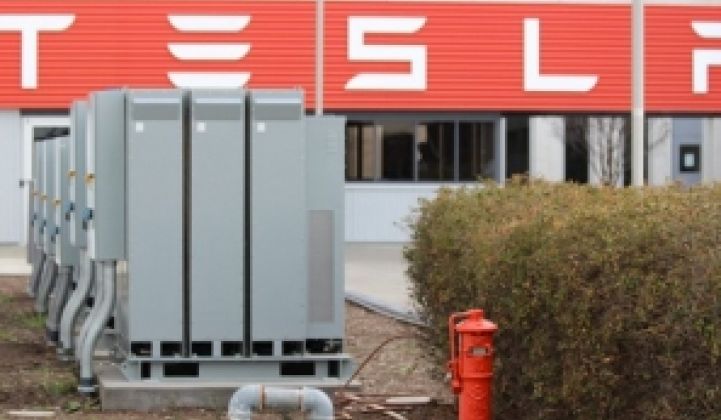Tesla and Elon Musk have a sparkly announcement coming tonight about driverless cars or all-wheel drive or Musk's D or Heavy D or something.
We will bring you news and analysis from Southern California as soon as that hype breaks.
In the meantime, we heard from Tesla's Director of Powertrain Business Development, Mateo Jaramillo, the keynote speaker at last week's Energy Storage North America. He spoke of Tesla's aggressive efforts in stationary storage.
Jaramillo leads the efforts to commercialize Tesla's electric powertrain technology for applications without wheels. That includes Tesla’s battery systems, electric motors, power electronics and chargers. Jaramillo incubated the stationary storage project within Tesla. The executive discussed how grid storage and stationary energy storage fits into Tesla's vision.
Jaramillo noted that the company's overarching goal is to accelerate the advent of sustainable transportation, not just build cars. As Tesla CTO JB Straubel said in a previous interview, Tesla was founded as an energy innovations company.
"The mission of Tesla Motors," penned by Elon Musk in 2006, as told by Jaramillo, has been to:
- Build a sports car
- Use that money (and some money from the DOE) to build an affordable car -- the Model S ("We're working on the affordable part," said Jaramillo)
- Use that money to build an even more affordable car
- And "the little known fourth point, the lost Beatle if you will," said Jaramillo, is to provide a zero-emission electric power generation option. "That was really a founding principle of the company," said Jaramillo.
As we've reported, Tesla has 4 megawatt-hours of battery "operating at the plant right now" in peak reduction and demand response applications.
Jaramillo said that the Powertrain Group is becoming "more and more focused on stationary storage." He spoke of past near-disasters in battery development "deeply seared into the engineering memory of our company," which have shown that the sustainable path forward "was to do the complete system ourselves."
Jaramillo rattled off some Tesla stats:
- Tesla has developed seven automotive products in six years and sold more than 40,000 vehicles.
- There is about 4 gigawatt-hours of Tesla battery "storage that's out there in the world."
- That's a total of 12 gigawatts of bidirectional inverters operating at their peak about once a day.
- Over 200 superchargers are delivering 1 gigawatt-hour a month.
"At its peak capacity, [the Giga factory] will produce 50 gigawatt-hours of storage per year. [...] It's sized to produce enough for about 500,000 vehicles per year."
He spoke of an eventual 1.5 terawatt-hours of additional load being needed in order to charge those vehicles. And he said that means "$500 million of revenue that comes out of the oil and gas industry and into the electric industry."
Jaramillo said, "Tesla has new industrial and residential units coming out next year at compelling price points,"
He said he was disappointed to hear recent reports out of Germany that dismissed batteries as too expensive. He suggested that doubters "shouldn't make that statement until they talk to us about the price of Tesla batteries. People are surprised when we have that conversation about Tesla battery prices."
He concluded, "We see demand going non-linear as soon as we cross the commodity price line -- and sooner than most people might expect."




